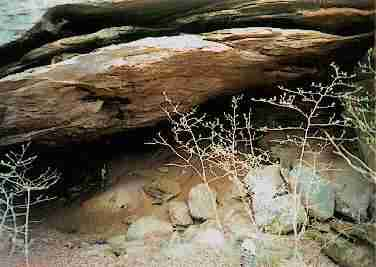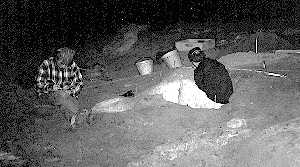Cave Archeology
 Throughout history, Man has been drawn by the lure of caves. In the past, caves were used for shelter, religious rites, and acquisition of decorative minerals. This is particularly true of Wyandotte Cave, a state-owned property with considerable archeological significance. However, signs of human habitation are occasionally found in other Indiana caves as well.
Throughout history, Man has been drawn by the lure of caves. In the past, caves were used for shelter, religious rites, and acquisition of decorative minerals. This is particularly true of Wyandotte Cave, a state-owned property with considerable archeological significance. However, signs of human habitation are occasionally found in other Indiana caves as well.
Pictured is a rock shelter in Crawford county known for its content of Native American artifacts. This site was the subject of an archeological dig in mid- 1997. Research focused on defining the level and degree of prehistoric occupation. Although extensively damaged, excavations revealed intact artifactual deposits left by Native Americans of the Early Archaic period (8,000-5,500 BC). Angie Krieger, archeologist for the USDA Forest Service, can be seen standing in the entrance; giving some idea of the scale of this photograph. The photo below shows researchers from Ball State University conducting excavations.

Unfortunately, this site has also seen a great deal of looting over the years, and much of the potential for scientific discovery has been lost. Like paleontological remains, artifacts are best collected only by trained personnel. These non-renewable resources are part of our nation's heritage and have great potential to teach us about our past. If you should find signs of ancient human visitation in caves, please leave everything as you found it and contact either the Indiana State Museum or the IKC for assistance. Photos courtesy USDA Forest Service and Ball State University |

